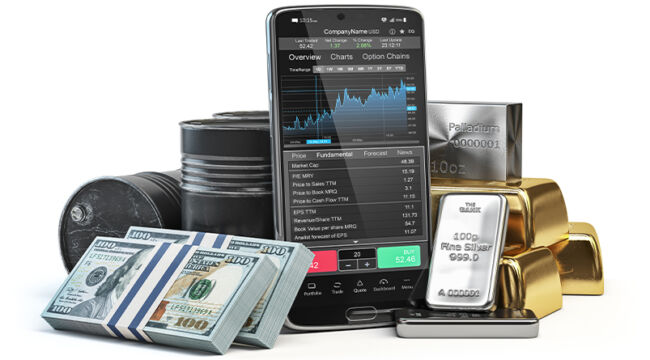The Emerging Commodities Supercycle
One hundred and three steps. That’s how much I had to climb to bring my grandpa his lunch every day at the ore dock.
Marquette, Michigan is the hub of America’s iron industry. It’s where I grew up. My grandpa was the loadmaster at the town’s famous ore dock. He spent his entire career working around iron — from iron rails, to ore boats, to where he retired, in Marquette.
Some 500 million tons of the metal have shipped out from the dock since it was first established. An additional 10 million tons of iron still flow out every year.
That gave me an extremely unique perspective growing up. When you grow up in an
iron town, you can see the cycles of boom and bust for yourself.
When demand was low, the town entered a slump. Stores closed. People had to cut back.
But when demand was high, the town came alive. I took this perspective with me to Chicago to trade in the city’s futures pits.
There, I traded alongside some of the world’s best traders, an experience that helped make me what I am today.
Having said all that, where are we today? What’s happening now?
Based on my connections in Chicago… my smart money indicators… and what I can see with my own eyes right here in Marquette, I believe we’re on the cusp of a massive supercycle in the resource market that will last for years.
Chicago, as you may know, is the center of the global commodities and options markets. Some $1 quadrillion in derivatives trade through the Chicago Mercantile Exchange (CME) group every year. Chicago is also home to the Chicago Board Options Exchange (CBOE). They’re two of the most important financial institutions in the world.
When people think about markets, they think about Wall Street. During stock booms, you wanted to be in New York.
But during resource booms, you wanted to be in Chicago.
I got to trade on the floor during the supercycle in the 2000s, when gold shot up almost 1,000%, and other commodities like oil, natural gas, iron, steel and uranium followed suit.
Back then, you really had to be on the floor to get a piece of the action. Today, it’s never been easier. Anyone can take advantage of moves in the resource market inside a standard brokerage account and be in a high-probability trade within minutes.
I’ll tell you about one of my favorite trading setups right now in a moment. First, let me show you the big picture.
Since the U.S. financial crisis, the U.S. stock market has climbed over 500%. And yet the GSCI — or Goldman Sachs Commodity Index — has gone up approximately 0%. It went up… then down… then up again… and today is trading right about where it was when the market bottomed in 2009.
This has created the widest spread between stocks and commodities in 50 years. And it’s created what is probably the greatest macro environment for traders that I’ve ever seen.
Whenever commodity prices were this cheap compared with the stock market, they soared higher for years. And each time, they beat stocks by a long shot.
During the 1970s, the commodities index shot up 700%. That same decade, stocks suffered a 50% downturn. Commodities shot up again between 1986 and 1991, rising 200%. That same period, we saw Black Monday, the worst day for the stock market in history.
And during the 2000s, commodity prices went up 400% on average. During that same time, the stock market fell 50%… twice.
Am I predicting stocks are about to fall 50%?
Not exactly. See, I’m actually quite bullish. I’m an optimist by nature. But it’s clear to me right now that while the stock market is at all-time highs, the commodities market is where you need to have some exposure for the next several years.
Over the last 15 years, we’ve seen a huge bull market in tech. But the physical world has suffered as a result. We’re at critical points of malinvestment across the entire resource market. And it’s made everything very expensive.
Go in any major American city and try to count the number of roads that are falling apart. The American Society of Civil Engineers estimates $13 trillion is needed between now and 2039 to repair not just our roads, but our dams, bridges, waterways, rails, seaports, airports and sewage systems.
In India, 100 million people are entering the middle class every year. That means 24/7 AC, lighting and refrigeration. They’re going to need gratuitous amounts of energy in the forms of coal, oil and natural gas.
China has reserved almost $500 billion to modernize its energy system with nuclear power. That will require tons of iron, steel and uranium.
The list of projects goes on and on. For traders, this has created the opportunity of a lifetime.
You see, some of the greatest trading stories in history have come out of the resource market.
In the 1970s, Richard Dennis turned a $400 stake into $350 million in about six years. Yes. He turned four hundred dollars, a four and two zeroes, into three hundred and fifty MILLION.
Another commodities trader, Ed Seykota, turned $5,000 into $15 million in 12 years. And in the ’70s, one of the most famous commodities traders to ever live, Jim Rogers, grew his hedge fund by 4,000%, beating stocks nearly 100-to-1.
Today, we are seeing a similar setup. While most investors have been so focused on tech stocks like Nvidia, they’ve ignored DEEP value in parts of the resource market.
Which brings me to my ultimate trade for the second half of 2024, and beyond. My favorite setup for the second half of 2024
As you know, gold recently broke out of the $2,000 level for the first time ever this year, and recently traded for as high as $2,450 per ounce.
This is massive. Gold almost touched $2,000 back in 2011 before dropping over 40%. It touched it again in 2020, and then backed off again. Then again in 2022…
Now finally, it has decisively cleared that hurdle. But I think it can still go a lot higher than most people expect. And soon. Central banks are loading up faster than ever. And gold miners can’t mine enough gold to keep up with demand.
This happens every time during a supercycle in commodities. It can take years for supply to catch up to demand due to the sheer amount of time it takes to get resources out of the ground.
And yet despite gold’s all-time highs, gold mining stocks are nowhere CLOSE to their all-time highs. In fact, gold miners are trading at their cheapest levels relative to the price of gold in 25 years.
This is setting up my favorite trading opportunity for the second half of 2024. I call it “The Ultimate Gold Trade.”
You see, there’s one miner that has been performing remarkably well over the last year. Last year, free cash flow nearly doubled. It’s made key acquisitions and is investing in production. And it’s all around just an extremely well-run company.
My smart-money indicators have even shown me that big investors are starting to put a lot of money down on the stock.
As miners start to catch up to the price of gold, EVERYTHING is telling me that investors are about to pile into this stock.
A single trade on this stock stands to return as much as 5,000% by January if this situation plays out the way I expect.



Comments: